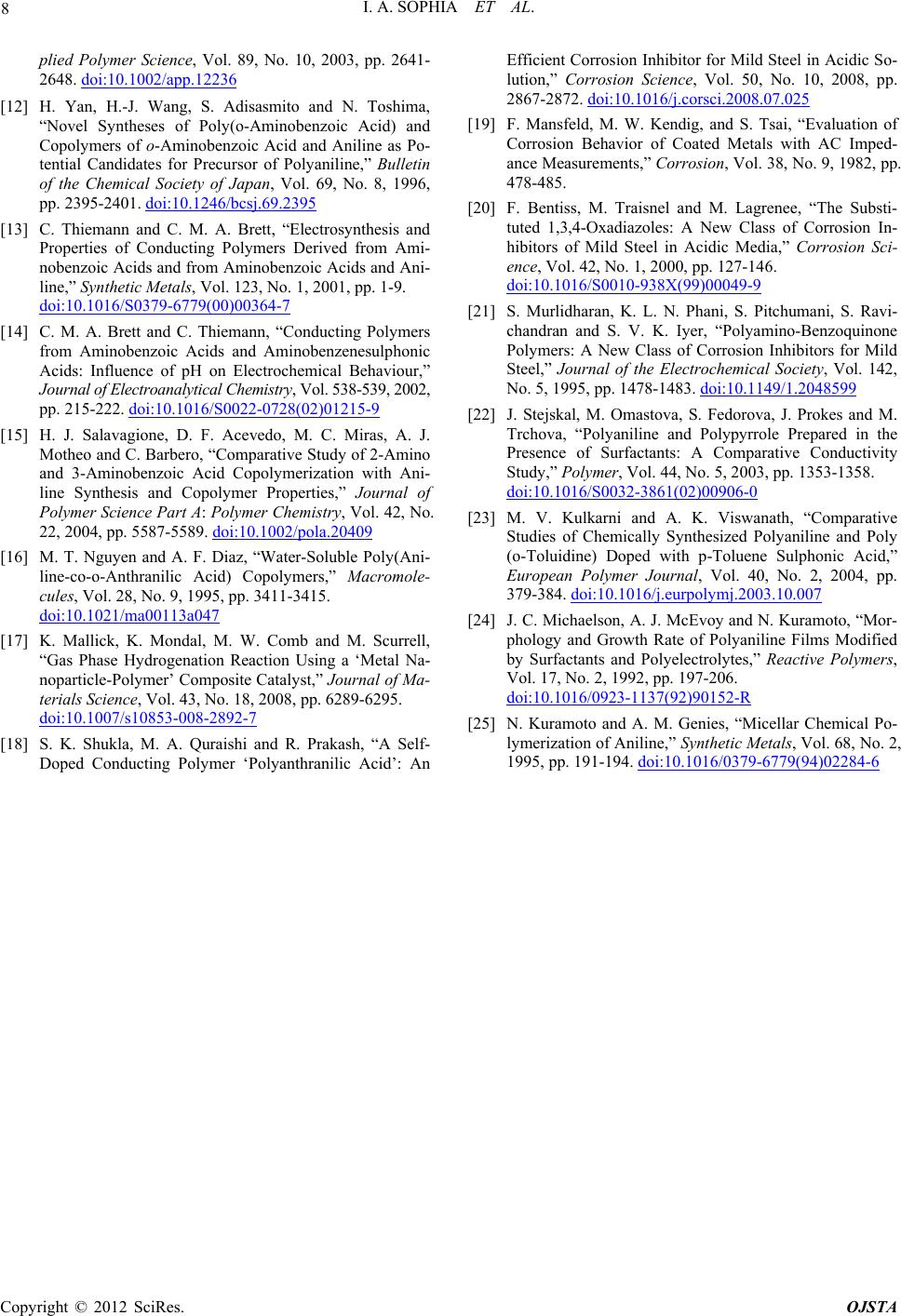
I. A. SOPHIA ET AL.
8
plied Polymer Science, Vol. 89, No. 10, 2003, pp. 2641-
2648. doi:10.1002/app.12236
[12] H. Yan, H.-J. Wang, S. Adisasmito and N. Toshima,
“Novel Syntheses of Poly(o-Aminobenzoic Acid) and
Copolymers of o-Aminobenzoic Acid and Aniline as Po-
tential Candidates for Precursor of Polyaniline,” Bulletin
of the Chemical Society of Japan, Vol. 69, No. 8, 1996,
pp. 2395-2401. doi:10.1246/bcsj.69.2395
[13] C. Thiemann and C. M. A. Brett, “Electrosynthesis and
Properties of Conducting Polymers Derived from Ami-
nobenzoic Acids and from Aminobenzoic Acids and Ani-
line,” Synthetic Metals, Vol. 123, No. 1, 2001, pp. 1-9.
doi:10.1016/S0379-6779(00)00364-7
[14] C. M. A. Brett and C. Thiemann, “Conducting Polymers
from Aminobenzoic Acids and Aminobenzenesulphonic
Acids: Influence of pH on Electrochemical Behaviour,”
Journal of Electroanalytical Chemistry, Vol. 538-539, 2002,
pp. 215-222. doi:10.1016/S0022-0728(02)01215-9
[15] H. J. Salavagione, D. F. Acevedo, M. C. Miras, A. J.
Motheo and C. Barbero, “Comparative Study of 2-Amino
and 3-Aminobenzoic Acid Copolymerization with Ani-
line Synthesis and Copolymer Properties,” Journal of
Polymer Science Part A: Polymer Chemistry, Vol. 42, No.
22, 2004, pp. 5587-5589. doi:10.1002/pola.20409
[16] M. T. Nguyen and A. F. Diaz, “Water-Soluble Poly(Ani-
line-co-o-Anthranilic Acid) Copolymers,” Macromole-
cules, Vol. 28, No. 9, 1995, pp. 3411-3415.
doi:10.1021/ma00113a047
[17] K. Mallick, K. Mondal, M. W. Comb and M. Scurrell,
“Gas Phase Hydrogenation Reaction Using a ‘Metal Na-
noparticle-Polymer’ Composite Catalyst,” Journal of Ma-
terials Science, Vol. 43, No. 18, 2008, pp. 6289-6295.
doi:10.1007/s10853-008-2892-7
[18] S. K. Shukla, M. A. Quraishi and R. Prakash, “A Self-
Doped Conducting Polymer ‘Polyanthranilic Acid’: An
Efficient Corrosion Inhibitor for Mild Steel in Acidic So-
lution,” Corrosion Science, Vol. 50, No. 10, 2008, pp.
2867-2872. doi:10.1016/j.corsci.2008.07.025
[19] F. Mansfeld, M. W. Kendig, and S. Tsai, “Evaluation of
Corrosion Behavior of Coated Metals with AC Imped-
ance Measurements,” Corrosion, Vol. 38, No. 9, 1982, pp.
478-485.
[20] F. Bentiss, M. Traisnel and M. Lagrenee, “The Substi-
tuted 1,3,4-Oxadiazoles: A New Class of Corrosion In-
hibitors of Mild Steel in Acidic Media,” Corrosion Sci-
ence, Vol. 42, No. 1, 2000, pp. 127-146.
doi:10.1016/S0010-938X(99)00049-9
[21] S. Murlidharan, K. L. N. Phani, S. Pitchumani, S. Ravi-
chandran and S. V. K. Iyer, “Polyamino-Benzoquinone
Polymers: A New Class of Corrosion Inhibitors for Mild
Steel,” Journal of the Electrochemical Society, Vol. 142,
No. 5, 1995, pp. 1478-1483. doi:10.1149/1.2048599
[22] J. Stejskal, M. Omastova, S. Fedorova, J. Prokes and M.
Trchova, “Polyaniline and Polypyrrole Prepared in the
Presence of Surfactants: A Comparative Conductivity
Study,” Polymer, Vol. 44, No. 5, 2003, pp. 1353-1358.
doi:10.1016/S0032-3861(02)00906-0
[23] M. V. Kulkarni and A. K. Viswanath, “Comparative
Studies of Chemically Synthesized Polyaniline and Poly
(o-Toluidine) Doped with p-Toluene Sulphonic Acid,”
European Polymer Journal, Vol. 40, No. 2, 2004, pp.
379-384. doi:10.1016/j.eurpolymj.2003.10.007
[24] J. C. Michaelson, A. J. McEvoy and N. Kuramoto, “Mor-
phology and Growth Rate of Polyaniline Films Modified
by Surfactants and Polyelectrolytes,” Reactive Polymers,
Vol. 17, No. 2, 1992, pp. 197-206.
doi:10.1016/0923-1137(92)90152-R
[25] N. Kuramoto and A. M. Genies, “Micellar Chemical Po-
lymerization of Aniline,” Synthetic Metals, Vol. 68, No. 2,
1995, pp. 191-194. doi:10.1016/0379-6779(94)02284-6
Copyright © 2012 SciRes. OJSTA